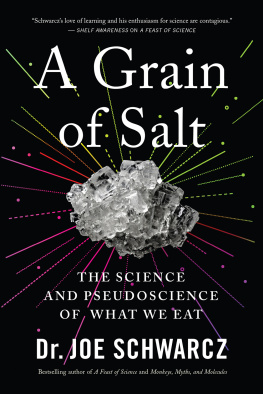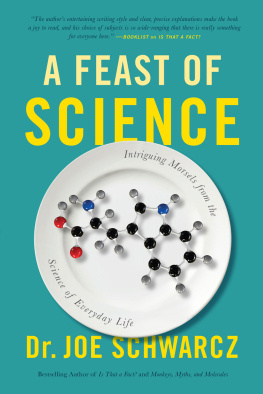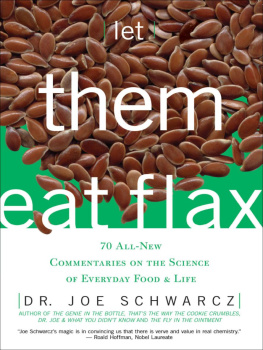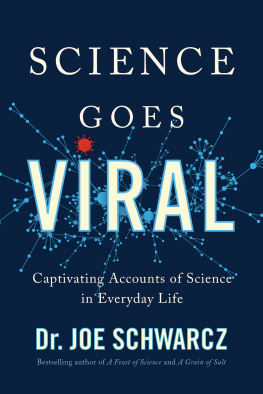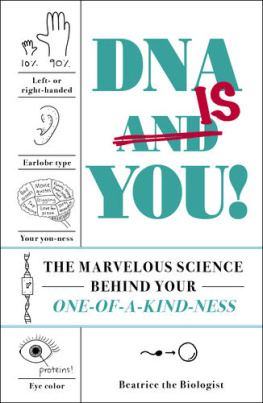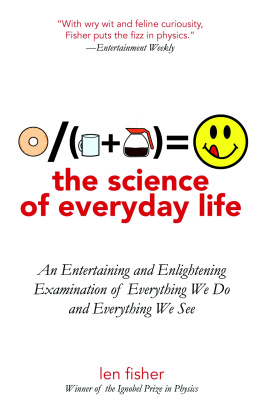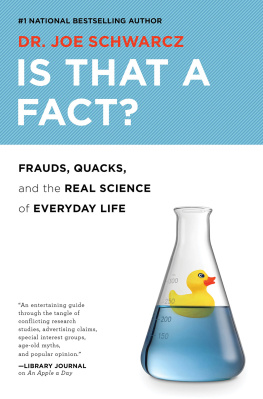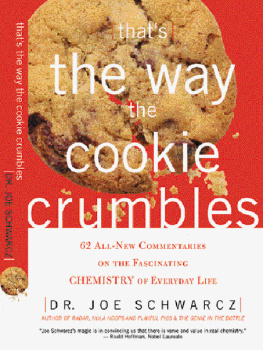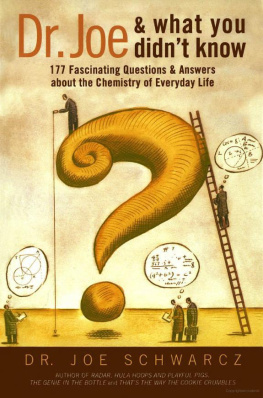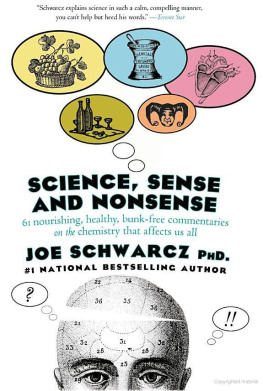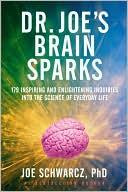Schwarcz - The fly in the ointment: 70 fascinating commentaries on the science of everyday life
Here you can read online Schwarcz - The fly in the ointment: 70 fascinating commentaries on the science of everyday life full text of the book (entire story) in english for free. Download pdf and epub, get meaning, cover and reviews about this ebook. City: Toronto;Ontario;Canada, year: 2013, publisher: ECW Press, genre: Science. Description of the work, (preface) as well as reviews are available. Best literature library LitArk.com created for fans of good reading and offers a wide selection of genres:
Romance novel
Science fiction
Adventure
Detective
Science
History
Home and family
Prose
Art
Politics
Computer
Non-fiction
Religion
Business
Children
Humor
Choose a favorite category and find really read worthwhile books. Enjoy immersion in the world of imagination, feel the emotions of the characters or learn something new for yourself, make an fascinating discovery.

The fly in the ointment: 70 fascinating commentaries on the science of everyday life: summary, description and annotation
We offer to read an annotation, description, summary or preface (depends on what the author of the book "The fly in the ointment: 70 fascinating commentaries on the science of everyday life" wrote himself). If you haven't found the necessary information about the book — write in the comments, we will try to find it.
Schwarcz: author's other books
Who wrote The fly in the ointment: 70 fascinating commentaries on the science of everyday life? Find out the surname, the name of the author of the book and a list of all author's works by series.
The fly in the ointment: 70 fascinating commentaries on the science of everyday life — read online for free the complete book (whole text) full work
Below is the text of the book, divided by pages. System saving the place of the last page read, allows you to conveniently read the book "The fly in the ointment: 70 fascinating commentaries on the science of everyday life" online for free, without having to search again every time where you left off. Put a bookmark, and you can go to the page where you finished reading at any time.
Font size:
Interval:
Bookmark:
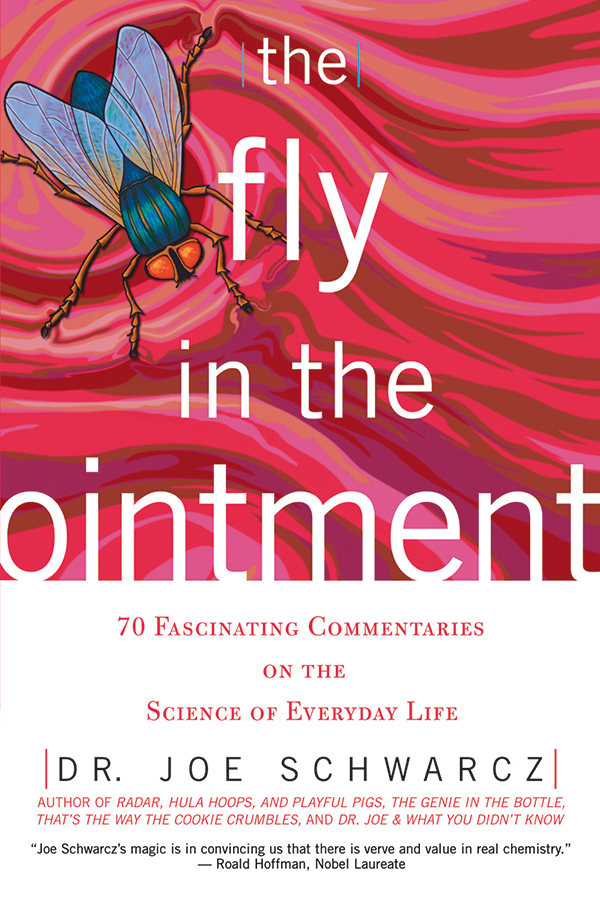
THE FLY IN THE OINTMENT
70 Fascinating Commentaries on the Science of Everyday Life
DR. JOE SCHWARCZ
Director
McGill University Office for Science and Society
ECW PRESS
INTRODUCTION
T HE F LY IN THE O INTMENT
Many of you may not remember the ditto machine, but I sure do. I dont know what I would have done without it back in 1973 when I first started teaching. It offered the only quick, cheap way to produce handouts for students. Reproduction required a stencil, which was made of a master sheet attached to a backing sheet treated with purple ink. The pressure created by writing or typing caused the ink to be transferred to the back of the master, which would then be peeled off and wrapped around the metal drum of the duplicating machine. This drum was connected to a container of methanol by a wick, and as the drum turned the methanol softened the ink and transferred it onto blank paper. Several dozen copies could be produced before the ink ran out.
I mention this anecdote because I vividly recall the first such stencil I ever produced. I had just graduated with a Ph.D. in chemistry and was keen on communicating my knowledge to students. The only problem was that I didnt have very much knowledge to communicate. Or at least not the type I thought I should be communicating. Oh, I was pretty good at atomic structures, chemical bonding, reaction mechanisms, and even thermodynamicsall fundamental concepts that any chemistry student should master. But I knew precious little about real-world chemistry. That had not been part of my chemical education. I knew how to interpret complex spectra but had no idea why carrageenan was added to ice cream. I knew how to make carbon 13enriched glucose in the lab but would have been totally stymied if someone had asked me to make lipstick. I discovered that when friends and relatives learned I was studying chemistry, they were more likely to ask me questions about toothpaste or shoe polish than about the nuances of the Schrdinger wave equation.
I decided that when I finally got the chance to teach, I would always try to weave these everyday applications into my courses. Luckily, my very first year on faculty I had the opportunity to develop a new course that was to feature dyes, cosmetics, cleaning agents, medications, synthetic fabrics, and the other common fruits of chemistry. These were just the kinds of things I was interested in, but curiously, Chemistry in the Modern World was to be offered only to nonscience students! The pedagogical mentality at the time suggested that such fluff was fine for arts students, but there was no room for it in real chemistry courses. Science students were to struggle with phase diagrams and molecular orbitals, not with ways to remove lipstick stains from collars. My view was that these real-world examples should be part and parcel of any chemistry course.
Nevertheless, I was thrilled to be able to teach my arts students about stuff I thought really mattered. I thought they should learn about suntan lotions, preservatives, chemotherapy, shampoos, and air pollution. I thought they should learn that chemistry is a living science and that there is always some breaking news. So I took to starting each class with a ditto handout about some current chemical happening. One day it might have been about the benefits of a newly introduced medication, and the next it might have mentioned the wonders of a novel plastic. The more I pursued this practice, the more I became captivated by the scope of chemistry. But something else happened as well: I began to realize that there is always a but. That new drug may perform well most of the time, but sometimes there are severe side effects. That new plastic may have fantastic properties, but there are environmental concerns linked to its production.
In other words, I discovered that there is often a fly in the ointment. It became clear to me that any realistic discussion of chemical issues had to involve an appropriate risk-benefit analysis. And that is just the approach that my colleagues, Ariel Fenster and David Harpp, and I now take as we offer applied chemistry courses to over 1,000 students from all disciplines at McGill University in Montreal, Canada, every year. In fact, we have given these four courses to almost 14,000 students over the past twenty-four years. Much has changed since my initial attempts to offer a relevant chemistry course in 1973. Today, our lectures are available on the Web www.oss.mcgill.ca and ditto handouts have been relegated to the dustbin of technology. But I still recall those old dittos with a certain degree of fondnessafter all, they did spark many a fruitful discussion. I also remember, though, the headaches I used to get from the methanol vapors when I was running off all those handouts. You see, there was a fly in that ointment as well. So as you journey through the following pages, you too may encounter some flies. Youll have to judge for yourself just how much they contaminate the ointment.
HEALTH ISSUES
L IES , D AMNED L IES , AND S TATISTICS
I overheard an interesting conversation between two young women as I was waiting in line to ride The Comet, the granddaddy of roller coasters at Great Escape Fun Park in upper New York State. One was preparing to study in Australia and was describing her travel plans. Her friend thought Australia would be exciting but added that she would never go herself because flying was too dangerous. The prospective traveler responded that she wasnt concerned about a plane crash but was worried about the risk of developing deep vein thrombosisa potentially fatal blood clotduring the trip. As soon as I heard this comment I knew that she must have watched the same TV talk show I had the day before.
While the specifics of this conversation might have been unique, the gist of it was not. Details aside, the young women were involved in risk evaluation, something we all do on a regular basis. Just think about how often we ask ourselves whether or not we should be worried about mercury in tuna, radiation from cell phones and microwave ovens, aspartame in diet drinks, and the reported link between estrogen supplements and an increased risk of cancer. Life often comes down to analyzing risks. But most people do not realize how difficult it is to perform this analysis in a meaningful way.
Lets start with something easy, like the risks of air travel. Flying is actually remarkably safe. Since the advent of commercial air transport around 1914, some 15,000 people have perished in airplane crashes. In North America alone more than three times that many people die in automobile accidents every year! You are far more likely to arrive at your destination if you fly than if you drive. Unfortunately, traffic on the highways increased significantly after September 11, 2001, resulting in many deaths that would not have occurred if people had flown. So why are people so scared of flying? Because they dont think statisticallythey think emotionally. People have the perception that their destiny is in their own hands if they are driving a car; they feel that they have relinquished this control when flying on an airplane. Also, there is a greater likelihood of surviving a car crash than a plane crash, which is another factor that weighs on peoples minds. But the statistics show that over a lifetime, you are 100 times more likely to die in a car accident than in a plane crash. Basically, you are more likely to be struck by lightning or win the lottery than die in an air disaster. Flying to Australia is safer than driving to the Great Escape from New York City, which is what the two young women had done.
Now, about the deep vein thrombosis. The TV show I had seen focused on what has come to be called economy-class syndrome and began by recounting the tragic case of a healthy British woman in her late twenties who collapsed at Heathrow Airport in London after a long flight from Australia. She died within hours from a blood clot in her lung that had originally formed in her leg while she sat in a cramped position for an extended period. The show also included interviews with physicians in Hawaii who described similar incidents. There is no question that such deep vein thrombosis can occur, but the number of people who develop this condition is very small when compared with the number of passengers that fly. Indeed, a study reported in the New England Journal of Medicine found no association between air travel and deep vein thrombosis. On long flights, passengers should certainly be encouraged to move around, particularly if they are seniors, have a history of heart disease, are pregnant, or are taking estrogen supplements. The risk of deep vein thrombosis on a flight is a minute statistical blip, but if you take three victims and put them on a talk show together, viewers will think that the air travel industry is in midst of an epidemic.
Font size:
Interval:
Bookmark:
Similar books «The fly in the ointment: 70 fascinating commentaries on the science of everyday life»
Look at similar books to The fly in the ointment: 70 fascinating commentaries on the science of everyday life. We have selected literature similar in name and meaning in the hope of providing readers with more options to find new, interesting, not yet read works.
Discussion, reviews of the book The fly in the ointment: 70 fascinating commentaries on the science of everyday life and just readers' own opinions. Leave your comments, write what you think about the work, its meaning or the main characters. Specify what exactly you liked and what you didn't like, and why you think so.

